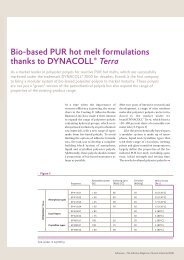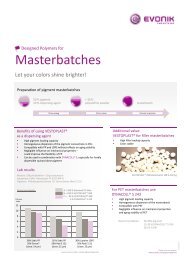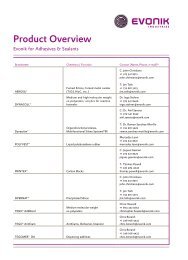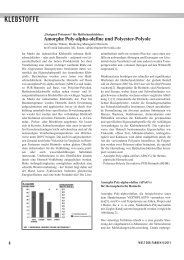Sales folder english - Adhesive Resins - Evonik Industries AG
Sales folder english - Adhesive Resins - Evonik Industries AG
Sales folder english - Adhesive Resins - Evonik Industries AG
You also want an ePaper? Increase the reach of your titles
YUMPU automatically turns print PDFs into web optimized ePapers that Google loves.
VESTOPLAST®<br />
Analytical Methods<br />
Melt Viscosity<br />
Determination according to DIN 53 019, modified.<br />
The melt viscosity is determined by a rotational viscosimeter. It describes the melting flow<br />
behaviour at 190 °C, high viscous grades exhibit a slight dependence on shear rate, low viscous<br />
grades are almost newtonian at elevated tempertaures.<br />
Softening Point (Ring & Ball)<br />
Determination according to DIN EN 1427.<br />
The material is heated up at 180 °C and then the melt is casted into a ring. After 24 h (this time<br />
is needed for recrystallization of the amorphous products) the sample is stressed concentrically<br />
with a chrome-plated steel ball and the test frame is immersed in a bath of glycerin. This is<br />
heated up with approx. 5 °C/min and the softening point is the temperature when the ball<br />
contacts the baseplate of the test frame.<br />
Needle Penetration<br />
Determination according to DIN EN 1426, modified.<br />
The material is heated up at 180 °C in a thin can. After 24 h (this time is needed for<br />
recrystallization of the amorphous products) the hardness of the product is determined with<br />
a needle and weight of 100 g at 25 °C. The penetration time into the sample is 5 s.<br />
Thermal Stability under Load / S.A.F.T.<br />
Determination according to <strong>Evonik</strong> method, similar to WPS 68.<br />
The thermal stability under load describes the thermal stability behaviour of bonded substrates.<br />
In case of VESTOPLAST® we use grey board to compare each VESTOPLAST® grade with<br />
another. A drop of the melt (180 °C) is placed on a side of the board and that is pressed to<br />
another grey board (T-form). After 24 h the prepared specimen are placed in a heating cabinet<br />
with a weight of 450 g and heated up with 5 °C/h. The thermal stability is the temperature<br />
when the bonded specimen breaks down.<br />
Tensile Strength / Elongation at Break<br />
Determination according to DIN EN ISO 527-3, modified type 5.<br />
The tensile strength describes the tensile and elongation properties of a specimen type 3 with<br />
2 mm thickness.<br />
Shear Modulus at 23 °C<br />
Determination according to DIN EN ISO 6721-2.<br />
This part specifies the general principles of a method for determining the dynamic rheological<br />
properties of polymer melts, part 2 described the Torsion-pendulum method.<br />
Molecular Weight Mn/Mw<br />
Determination according to GPC, DIN 55 672, modified.<br />
The molecular weight is calculated according to GPC, DIN 55672-1, detailed in Mn and Mw.<br />
Open Time<br />
Determination according to <strong>Evonik</strong> internal method.<br />
The melt (180 °C) is applied as a film of 20 μm on a paper. Strips of paper are pressed into the<br />
film at certain intervalls (depending on the open time). 30 minutes after the last strip has been<br />
applied, a test is carried out to see which of the last strips applied can be lifted off without<br />
pulling out the paper fibers. The time at which this strip was applied is noted.<br />
50












